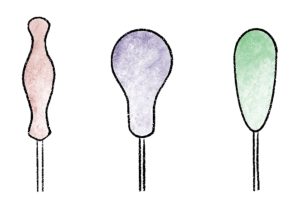4 The Baton
Amy Kotsonis
Learning Objectives
In this chapter, students will:
- Identify and practice proper baton position and hand grip, including common mistakes
- Practice correct vs. incorrect positioning of the baton to feel and see the difference
- Apply baton skills while conducting a musical example
To baton or not to baton
For many choral conductors, the baton is the most intimidating inanimate object they encounter on their conducting journey. As stated earlier, “Conducting, at it’s most basic, is an effort to represent aural images with physical movement.” The baton should support this idea, rather than cause it to be more convoluted. Traditionally, instrumental conductors use batons, and choral conductors often do not. There are many choral conductors who always use batons, and most will when conducting choral ensembles combined with instrumental ones. The question of whether to baton or not to baton should be given several considerations; none of those should be the conductor’s own comfort level with the baton. The goal of this chapter is to provide clear instructions on baton grip and position so that you feel comfortable with a stick in your hand. However, all the directions in the world will not make up for what can be gained with diligent practice. The more you use a baton, the more confident you will feel going into your next rehearsal or performance.
Choosing a Baton
A baton should be a helpful addition, rather than a hindrance. It’s important to find a lightweight baton that fits your body and hand size. If it’s too long or heavy, it can become unwieldy. If at all possible, trying out different batons in person will be the most helpful, but it may not always be possible. In a conducting class, your instructor may have specific requirements for what you are to purchase; once you have your own ensemble, that choice can be yours. It is said that the size of your baton should be the same as the length of your forearm; it does not need to be exactly that size, though it’s a good place to start. There are many different styles and colors of handles available now, and that choice is completely determined by personal preference.
 Different batons also have different balance points—this is where you hold the baton so that it “floats,” or is parallel to the ground without you manipulating it. Traditionally the balance point is where the handle meets the baton shaft; however, this is not always true, and again falls to personal preference of where you would like to hold the baton. Other considerations for baton size and color concern the conducting situation:
Different batons also have different balance points—this is where you hold the baton so that it “floats,” or is parallel to the ground without you manipulating it. Traditionally the balance point is where the handle meets the baton shaft; however, this is not always true, and again falls to personal preference of where you would like to hold the baton. Other considerations for baton size and color concern the conducting situation:
- How far will your ensemble be from you?
- Is the rehearsal/performing space well lit?
- What color are the walls?
- How many performers will you be working with?
The most common for choral directors is approximately 14-15 inches long with a white shaft, again, depending on the size and preference of the conductor.
Exploratory Practice
Conduct a 2/4 pattern with your baton in front of a mirror. Contrast the following elements, paying attention to how it feels in your arm and body, and how clear or not the ictus is in the mirror:
- Hand Position
- Palm facing the floor
- Palm perpendicular to the floor
- Balance Points
- Hold the baton where the handle meets the shaft
- Hold the baton slightly down the shaft
- Hold the baton a few millimeters from the intersection of shaft and handle on the wood
- Baton Position
- Conduct with the baton parallel to the floor
- Conduct with the tip pointing up
- Conduct with the tip pointing down
- Hand Grip:
- Thumb and Forefinger
- Examine the grip utilizing the pad of the thumb against the index finger first joint
- Examine the grip with the pad of the thumb against the pad of the index finger
- Examine the grip with the pad of the thumb against the second joint of the index finger
- Hold the baton firmly between the thumb and index finger
- Hold the baton very loosely between the thumb and index finger
- Hold the baton extremely tightly between the thumb and index finger
- Remaining Fingers
- Grip the remaining fingers gently around the handle
- Grip the remaining fingers firmly around the handle
- Handle Position
- Conduct with the handle loosely touching your palm
- Conduct with the handle pushing into your palm
- Thumb and Forefinger
- Forearm Position:
- Conduct with the baton at a 45° angle away from your body
- Conduct with the baton closer to 90° from your body
- Wrist Flexibility
- Perform the 2/4 pattern with no wrist movement
- Conduct the 2/4 pattern with a very floppy wrist
- Conduct the 2/4 pattern with a flexible wrist
Move through the conducting patterns of 3/4 and 4/4 in a similar fashion with your baton. Be mindful not only of the clarity of the ictus and pattern in the mirror, but of how it feels especially with regard to tension and fatigue.
Hand Position
The exploratory practice above likely illuminated several choices on efficient and effective baton positions. Since every person’s anatomy is unique, your choices may not be the same as the conductor next to you. The following suggestions will be appropriate the vast majority of conductors.
When utilizing a baton, keep the hand position similar to when conducting without; the baton is simply an extension of the hand. When holding a baton:
- Palm faces the ground
- Hold the baton at the balance point: where the handle meets the shaft
- Baton is placed between pad of thumb and near the first joint of the index finger; the rest of the fingers loosely wrap around it
- The angle of the baton should be closer to 90° away from the body, rather than at a 45° (or larger) angle
- Grip on the baton should be firm, but not tight
- Handle should lightly touch the palm of the hand (where on the palm will be determined by the shape of the handle, hand size, and balance point of the baton)
- Wrist should be slightly flexible, not rigid
Common Errors
- Holding the baton like a sword, with palm perpendicular to the ground. While palm is facing the ground, it should move as one unit with the hand, wrist, and forearm. If it moves too much on its own, the beat becomes less clear.
- Not holding the stick at the balance point—lightly holding the baton between thumb and index finger where the baton is parallel to the ground—is essential. If where you’re holding the baton causes it to be at an angle, adjust the location of your fingers on the baton.
- If the baton is held too high or low against the index finger, there will be less control, and it’s often more challenging to show a clear ictus. If the rest of the fingers are wrapped too tightly it causes unnecessary tension and fatigue, and too loose causes distraction with finger motion.
- Having the angle of the baton too close to a diagonal (45° angle) away from your body. This is less clear for the ensemble, particularly for those to the conductor’s right.
- Similar to the discussion on Body Mapping in Chapter 1, if the grip on the baton is too tight, there will be unnecessary tension and fatigue that extends through the arm into the shoulder. If it’s too loose, there will be little control over the stick.
- Depending on the size and shape of the handle, it will touch the palm of your hand; however, if it’s too far into your hand, you can lose control of the stick which causes an unclear beat pattern.
- If wrist is too rigid, there will be tension and fatigue felt throughout the arm, especially after a long rehearsal or performance. If wrist is too free, it’s difficult to show a clear ictus, and it will be a challenge for your ensemble to follow you.
The Baton Competency Check
With your teacher, demonstrate the following competencies in each of the simple patterns using your baton: (2/4, 3/4, 4/4)
- Pattern maintains a steady tempo
- Hand position maintains the palm facing down
- Wrist is slightly flexible and beat is clear
- Baton is parallel to the ground
- Student is directing the pattern with the end of the baton
Putting Practice into Context
With your teacher, demonstrate the following competencies:
- Pattern maintains a steady tempo
- Hand position maintains the palm facing down
- Wrist is slightly flexible and beat is clear
- Baton is parallel to the ground
- Student is directing the pattern with the end of the baton
The Baton Final Reflection Assignment
Observe a portion of a rehearsal or performance of a conductor using baton—ensure you can clearly see the front of the conductor. Write a brief paragraph describing the use of baton. What was the instrumentation of the ensemble? Was the conductor primarily an instrumental or choral director? What was the hand position of the conductor around the baton like? How did the conductor hold the baton? (Was their palm facing down while holding the baton? Stick always parallel to the floor? What was the angle of the baton with regard to the conductor?) Was the beat clear? Be specific why or why not.

